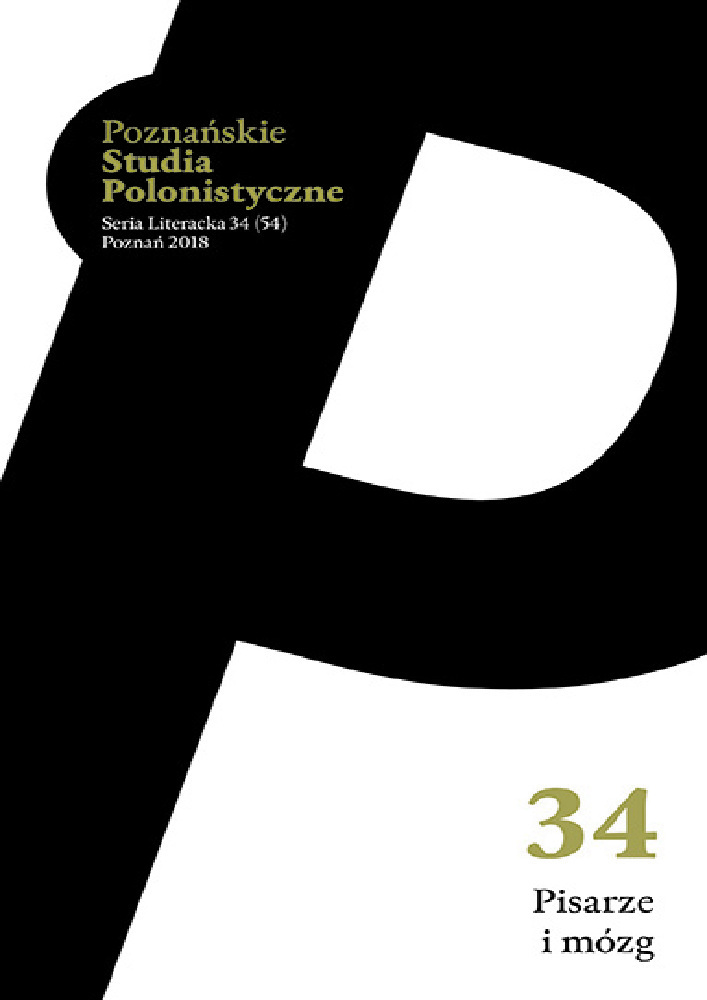Abstrakt
Multimodal techniques (meaning the use of narrative modes signalised by various typographies etc.) enable a fuller presentation of Caravaggio’s mental dysfunction (in the novel the focalizing role is performed by, among others, the notes of the painter who is falling into obsession and madness – it is these that form his internal storyworld). Confrontation with the journalistic account, provided by the alter ego of the very author of the novel (so called sylleptic narrator) – that is the second level of narration – constitutes the modal frame for the presentation of the artist’s fate and contributes to showing the mental state of Caravaggio who is obsessed with “black sun” (this obsession might be the source of the chiaroscuro technique), and who sees in hallucinations his own severed head. This way, Camilleri creatively exploits the motif of decapitation, found in Caravaggio’s paintings, following many research studies showing that the heads found in the paintings could have been the painter’s self-portraits and expressions of his expiation. This context is supplemented by reproductions of Caravaggio’s paintings, which are embedded in the narration and “commented upon” in his fictional journal, thus constituting yet another layer registering (and illustrating) what takes place in the artist’s mind.Bibliografia
Baldry Anthony, Thibault Paul J. (2010), Multimodal Transcription and Text Analysis: A Multimedia Toolkit and Coursebook, Equinox, London [Wielka Brytania].
Camilleri Andrea (2009), Kolor słońca, przeł. Anna Wasilewska, Noir sur Blanc, Warszawa.
Champagne John (2015), Caravaggio and the Melodramatic Sensibility, w: tegoż, Italian Masculinity as Queer Melodrama: Caravaggio, Puccini, Contemporary Cinema, Palgrave Macmillan, New York [USA], s. 56-84.
Gibbons Allison ( 2012), Multimodality, Cognition, and Experimental Literature, Routledge, New York [USA].
Guimón José (2006), Art and Madness, przeł. Eoin McGirr, Davies Group, Aurora Colorado [USA].
Herman David (2009), Beyond Voice and Vision: Cognitive Grammar and Focalization Theory, w: Point of View, Perspective, and Focalization.
Modeling Mediation in Narrative, red. Peter Hühn, Wolf Schmid, Jörg Schönert, Watler de Gruyter, Berlin [Niemcy].
Iedema Rick (2003), Multimodality, resemiotization: extending the analysis of discourse as multi-semiotic practice, „Visual Communication”, nr 2, s. 29-57.
Kristeva Julia (2007), Czarne słońce. Depresja i melancholia, przeł. Michał Paweł Markowski, TAiWPN Universitas, Kraków.
Langdon Helen (2003), Caravaggio, przeł. Stanisław Kroszczyński, Rebis, Poznań.
Łebkowska Anna (2002), O pragnieniu empatii w prozie polskiej końca XX wieku, „Teksty Drugie”, nr 5, s. 155-170.
Łebkowska Anna (2004), Pojęcie Focus w narratologii – problemy i inspiracje, w: Punkt widzenia w tekście i dyskursie, red. Jerzy Bartmiński, Stanisława Niebrzegowska-Bartmińska, Ryszard Nycz, Wydawnictwo UMCS, Lublin 2004, s. 219-238.
Maj Krzysztof M. (2015a), Allotopie. Topografia światów fikcjonalnych, TAiWPN Universitas, Kraków.
Maj Krzysztof M., (2015b), Czas światoodczucia. Imersja jako nowa poetyka odbioru, „Teksty Drugie”, nr 3, s. 368-394.
Markiewicz Piotr, Przybysz Piotr (2010), Neuroestetyczne aspekty komunikacji wizualnej i wyobraźni [online], [dostęp: 17 listopada 2010], http://www.staff.amu.edu.pl/~insfil/P_Przybysz/pdf/Neuroestetyka/4NeuroestAspekKomWizual.pdf.
McHale Brian (2012), Powieść postmodernistyczna, przeł. Maciej Płaza, Wydawnictwo Uniwersytetu Jagiellońskiego, Kraków.
Muraoka Anne H. (2015), The Path of Humility. Caravaggio and Carlo Borromeo, Peter Lang, New York [USA].
Nęcka Edward (1999), Proces twórczy i jego ograniczenia, Impuls, Kraków.
Nørgaard Nina (2010), Multimodality and the Literary Text. Making Sense of Safran Foer’s “Extremely Loud and Incredibly Close”, w: New Perspectives on Narrative and Multimodality, red. Ruth Page, Routledge, New York [USA], s. 117-126.
Nycz Ryszard (1994), Tropy „ja”. Koncepcje podmiotowości w literaturze polskiej ostatniego stulecia, „Teksty Drugie”, z. 2, s. 7-27.
Olkusz Ksenia, Olkusz Wiesław (2011a), Małe przestępstwa, wielkie literackie rozkosze. Intertekstualność w zbiorze opowiadań Andrei Camilleriego „Miesiąc z komisarzem Montalbano”, „Studia i Szkice Slawistyczne”, t. 11, s. 235-249.
Olkusz Ksenia, Olkusz Wiesław (2011b), Policjant erudyta. O literackich kontekstach w cyklu powieści kryminalnych o komisarzu Montalbano Andrei Camilleriego, „Prace Literackie”, nr 51, s. 137-153.
Olkusz Wiesław (2013), Filmowa wyobraźnia komisarza Montalbano.
O intertekstualności w prozie kryminalnej Andrei Camilleriego, „Literatura Ludowa”, nr 2, s. 47-61.
Page Ruth (2010), Introduction, w: New Perspectives on Narrative and Multimodality, red. Ruth Page, Routledge, New York [USA], s. 3-13.
Popek Stanisław Leon (2010), Psychologia twórczości plastycznej, Impuls, Kraków.
Seward Desmond (2003), Caravaggio. Awanturnik i geniusz, przeł. Rafał Albert Galos, Wydawnictwo Dolnośląskie, Wrocław.
Spitzmüller Jürgen (2007), Visible by Design: The Significance of Typography in Media Communication, Nihon University Tokyo, Working Group for Language and Media Studies 2/3, s. 1-10.
Stöckl Hartmut (2004), In between modes. Language and image in printed media, w: Perspectives on Multimodality, red. Eija Ventola, Cassily Charles, Martin Kaltenbacher, John Benjamins Publishing Company, Amsterdam [Holandia], s. 10-30.
Uniłowski Krzysztof (2016), Chmielewska mota intrygę, w: tegoż, Historia, fantastyka, nowoczesność. Szkice, Wydawnictwo Uniwersytetu Śląskiego, Katowice, s. 149-178.
Licencja
Autorzy
Autorzy tekstów przyjętych do publikacji w czasopiśmie „Poznańskie Studia Polonistyczne. Seria Literacka” są zobowiązani do wypełnienia, podpisania i odesłania na adres redakcji umowy o udzielenie nieodpłatnej licencji do utworów, z zobowiązaniem do udzielania sublicencji CC.
Zgodnie z umową, autorzy tekstów opublikowanych w czasopiśmie „Poznańskie Studia Polonistyczne. Seria Literacka” udzielają Uniwersytetowi im. Adama Mickiewicza w Poznaniu niewyłącznej i nieodpłatnej licencji oraz zezwalają na użycie sublicencji Creative Commons Attribution-NoDerivatives 4.0 International (CC BY-ND 4.0).
Autorzy zachowują prawa do dalszego, swobodnego rozporządzania utworem.
Użytkownicy
Zainteresowani użytkownicy internetu uprawnieni są do korzystania z utworów opublikowanych od 2016 roku w „Poznańskich Studiach Polonistycznych. Serii Literackiej” pod następującymi warunkami:
- uznanie autorstwa – obowiązek podania wraz z rozpowszechnionym utworem, informacji, o autorstwie, tytule, źródle (odnośniki do oryginalnego utworu, DOI) oraz samej licencji;
- bez tworzenia utworów zależnych – utwór musi być zachowany w oryginalnej postaci, nie można bez zgody twórcy rozpowszechniać np. tłumaczeń, opracowań.
Do wszystkich tekstów opublikowanych przed 2016 r. prawa autorskie są zastrzeżone.
Inne
Uniwersytet im. Adama Mickiewicza w Poznaniu zachowuje prawo do czasopisma jako całości (układ, forma graficzna, tytuł, projekt okładki, logo itp.).
